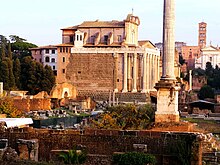Rostra aedis Divi Iuli
The Rostra aedis Divi Iuli are still visible today on the Roman Forum , which was built in front of the Temple of Divus Iulius as a speaker's platform ( Rostra ) and occupied the area of the lower, western podium of the actual cult building. In the middle of the porch, embedded in a semicircular niche, is the original object of worship: the place where Caesar's body is said to have been cremated. This opening was later walled up with tuff stone blocks, presumably to make the upper, additionally gained area usable for the extension of the grandstand. The platform was probably accessed via the staircases on both sides of the temple. From there, a flight of stairs opened up the temple building, which was erected on higher podiums.
Purpose of the rostra

In addition to its ideological and spiritual significance for the Romans , the temple initiated by the Senate and completed by Augustus embodied his claim to become the natural legal successor of the deified Caesar as an adopted son . After the victorious battle of Actium over Mark Antony and Cleopatra , the temple incorporated into Augustus' first building program, which gave his absolute claim to rule a visually perceptible form. The temple of Divus Iulius with its upstream rostra offered a suitable framework to effectively present one's own political and military successes to the public. For example, on the occasion of the temple inauguration on August 18, 29 BC. The ship's beaks of the fleet previously defeated at Actium were attached to the front of the Rostra.

The rostra aedis Divi Iuli , located to the east and facing the forum area , acted as a grandstand that was used for various occasions. It was thus the counterpart to the traditional Rostra from the Republican era , which had been moved to the west side of the area during the remodeling of the Roman Forum under Caesar. These formed with their eponymous ramming spurs ( Latin rostra ) from the Battle of Antium in 338 BC. BC the model of decorating the front of the new eastern counterpart with ship's beaks.
In addition to public speeches and matters - such as a documented voting procedure from June 30, 9 BC. BC, which took place in foro pro rostris aedis divi Iulii - the funeral ceremonies for Augustus and earlier for his sister Octavia were held by the rostra aedis Divi Iuli . The designated heir to the throne Tiberius and his son Drusus alternately presented a laudation funebris for Augustus, with Tiberius as the first speaker speaking from the eastern Rostra, and Drusus as the second speaker from the older, western tribune. This sequence of laudations, which, according to Cassius Dio, had also been adhered to at Octavia's funeral celebrations, emphasized the greater importance of the rostra aedis Divi Iuli compared to the older rostra Augusti in the Julio-Claudian period . At the latest with the construction of the rostra Diocletiani a few meters west of the forum square, the rostra of the Divus Iulius temple lost its function around the year 300.
Remarks
- ^ Frontinus , De aquaeductu urbis Romae, Lex Quinctia de aquaeductibus (Latin with English translation)
- ↑ Suetonius , Augustus 100,3 (English translation) .
- ↑ Cassius Dio , 54,35,5 (English translation)
literature
- Walter Hatto Gross : speaker's platform. In: The Little Pauly (KlP). Volume 4, Stuttgart 1972, column 1363 f.
- Klaus S. Freyberger : The Roman Forum. Second, revised and expanded edition. Philipp von Zabern, Darmstadt / Mainz 2012, ISBN 9783805344715 , p. 61.
Web links
- The Temple of Divus Iulius at Roma Antiqua - Rome on the Net
- Reconstruction proposal and information on the Caesar temple on the website of the 'digital forum romanum' of the Humboldt University of Berlin
- UCLA Digital Roman Forum, Aedes Divus Iulius
Coordinates: 41 ° 53 ′ 31.3 " N , 12 ° 29 ′ 9.9" E
